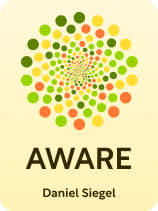

This article is an excerpt from the Shortform book guide to "Aware" by Daniel Siegel. Shortform has the world's best summaries and analyses of books you should be reading.
Like this article? Sign up for a free trial here.
How can you expand your consciousness and improve your overall well-being? What benefits might you experience from strengthening your awareness?
Aware, a book by Daniel J. Siegel, introduces a meditation tool called the Wheel of Awareness. This practice aims to enhance your focus, emotional health, and cognitive abilities. It also claims to offer physical benefits such as improved immune function and heart health.
Read on for an overview of Siegel’s book.
Aware Book Overview
Aware, a book by Daniel J. Siegel, claims that you can strengthen your mind, improve your focus, increase your social and emotional health, and boost your general sense of well-being by increasing your consciousness—your awareness of your life and your world. Increasing your consciousness also improves your bodily functions, thus enhancing your health and slowing your aging process. To achieve this, Siegel has developed a meditation tool he calls the Wheel of Awareness, which allows you to expand your capacity for awareness by visualizing and focusing on the connections between your body, your mind, and life around you. When used regularly, the Wheel meditation can revitalize and fortify your cognitive, mental, and physical health.
Siegel is a psychiatrist, author, and executive director of the Mindsight Institute, which promotes understanding of the mind by integrating neuroscience with concepts like mindfulness and compassion. He’s also a leading figure in the field of Interpersonal Neurobiology, which explores the connection between the brain, mind, and relationships. You can go to the author’s website to listen to a recording that’ll guide you through the Wheel meditation at DrDanSiegel.com.
In this overview, we’ll outline Siegel’s steps for using the Wheel and discuss the benefits of the meditation.
The Benefits of Awareness
According to Siegel, awareness is your perception of your experience of whatever is happening around and within you in the present moment. He asserts that people are happiest when living in the present moment—when you live more presently, you can cultivate deeper connections to yourself, others, and the world, and you’ll experience greater feelings of equanimity, peace, and meaning.
Additionally, strengthening awareness fosters mental flexibility, enabling you to be more adaptable and resilient in facing life’s challenges. Present-focused awareness allows for more thoughtful responses to experiences rather than automatic reactions. This healthy, flexible mind allows for comfort with uncertainty, moves beyond black-and-white thinking, and approaches difficult situations with greater ease. Expanded awareness can bring you more freedom, richness, and joy in life.
According to Siegel, research suggests that expanding your awareness not only brings mental and cognitive benefits, but can also yield physical benefits. By increasing your awareness, you can enhance your immune system, fortify the processes in your body that repair DNA, reduce stress responses, and improve your cholesterol levels, blood pressure, and heart health.
The Parts of the Wheel
Siegel writes that you can expand your mind’s capacity for awareness and improve your ability to live in the present moment by regularly meditating using the Wheel of Awareness. This mediation tool uses the image of a wheel and its various parts to guide you through different exercises to increase your consciousness of awareness.
Picture a simple wheel: The hub represents your awareness in the center of the wheel. The wheel’s outer rim represents all the things you can focus your attention on, like thoughts, feelings, sensations, and perceptions. Your awareness in the center hub is connected to the outer rim by a spoke, which represents your attention. As your attention shifts to different aspects of your world, the spoke moves around the circle.
The rim of this wheel is divided into four parts.
- The first section represents everything you can be aware of through your five senses—sounds, sights, smells, tastes, and touch sensations.
- The second section represents your perceptions of your body, such as how your muscles feel or the sensations in your gut.
- The third section represents psychological activities such as thoughts, feelings, and memories.
- The fourth section represents your experiences of connection to and relationships with others.
Prepare to Do the Wheel Meditation
Before you start meditating using the Wheel meditation, Siegel recommends you prepare and strengthen your focused attention skills with some basic meditation techniques that focus on your breath. Siegel recommends you practice breath meditation on a regular basis before diving into the Wheel.
To practice simple breath meditation:
- Find a quiet, comfortable space free of distractions. Get into a comfortable sitting position with your back straight, or lie down if that’s more comfortable for you. Keep your eyes open or closed as needed—whichever helps you maintain alertness better.
- Breathe through your nose if possible. Focus on the sensation of the air moving in and out of your nostrils, and try to let that sensation become the sole focus of your attention.
- Move your attention to the sensations of breathing that you can feel in your chest and belly. Then let your attention rest on the sensations of breathing wherever it feels the easiest to pay attention to your breath.
- Your mind will inevitably wander from the sensation of breathing. When it does, gently bring your attention back to your breath.
Siegel suggests you adopt a kind attitude toward yourself during your meditation sessions. Don’t judge when your mind drifts—accept it as a normal part of the process.
Practice the Wheel Meditation
To meditate with the Wheel, Siegel recommends you take a few moments to do the breath meditation you’ve been practicing. Then move your spoke of attention through the four Wheel sections. The full meditation takes around 30 minutes:
Section #1: Your Five Senses
First, with your eyes closed, picture the Wheel of Awareness as described above and imagine yourself in the center, the hub of awareness. Next, imagine sending your attention out from the hub like a spoke to the first section of the rim: your five senses. Begin to focus on the sensations you can perceive with each sense. Start with the sensations of hearing and move to sight, smells, taste, and touch (sensations coming in through your skin, like how your clothes feel or the temperature). Focus on each sense for at least 15 to 30 seconds.
Section #2: Your Body Sensations
Next, take a deep breath and move your spoke of attention to the second section of the rim: the internal sensations of your body. As you move through this section, focus your awareness on each part of your body for at least five to 15 seconds. Begin with your face, then move your awareness to your forehead, scalp, down the sides of your head, to your ears and neck. Then, move on to your shoulders and down both arms to your hands and fingers. Come back to your upper back and chest and down to your lower back and abdomen. Then, go to your hips, down both legs, feet, and toes.
Next, come back up and focus your attention on the sensations in your pelvic area, including your genitals, then up to your intestines and your stomach. Then, move up through your chest and esophagus to the inside of your mouth, the sinuses behind your cheekbones, the inside of your nose, and then back down your throat into your lungs. Feel both of your lungs expand and contract. Then, move your attention to your heart. And lastly, expand your attention and try to become aware of the inside of your entire body at once.
Section #3: Your Mind
Now, take a deep breath and move your spoke to the third section of the wheel: the mental processes of your thoughts, memories, emotions, daydreams, and so on. In this section, don’t focus your attention on sensations. Instead, open your awareness to notice whatever comes up in your mind. Try to stay with this section for at least a minute and a half.
Recall that Siegel says there’s nothing that’s supposed to come to mind during this section—allow whatever happens in your mind to happen and just notice it. Try to notice how something like a thought or feeling first appears in your awareness—does it pop in suddenly or come on slowly? Once it’s there, does it stick around for a while or leave quickly? Does your mental space feel chaotic or clear? Can you sense a gap between each thought, memory, or emotion? Or do they rush in one right after the other?
Then, practice becoming aware of your own awareness. To do this, imagine bending the spoke of your attention back toward the center of the wheel so that you can practice being aware of your awareness itself. Try to become aware of your own awareness for at least one minute. Siegel writes that when first practicing the Wheel meditation, you can skip this part of the process. Instead, when doing this section, focus only on your mental thoughts as described above. Once you’ve gained mastery of the meditation, you can add in this step of becoming aware of your awareness.
Section #4: Interconnection and Kind Intentions
Again, take a deep breath and imagine moving the Spoke to the fourth section of the rim: your sense of connection to others. Begin by letting yourself become aware of your connection to the people and animals physically closest to you. Then, expand that sense of connection to the friends, family, and animals not physically close to you. Next, move your awareness to the people and animals you spend time with at work, school, and community. Then, expand your relational connection to all the beings in your neighborhood, your town or city, region or state, and then to all the beings living in your country and continent. Lastly, try to reach your sense of connection out to encompass the planet.
Finally, extend kind intentions—loving and kind well-wishes—to all the living beings in your life, especially to other people.
- Start by saying these simple expressions aloud or silently to yourself: “May all living beings be happy. May all living beings be healthy. May all living beings be safe. May all living beings flourish and thrive.”
- Next, move on to the following statements, which add more detail to the expressions: “May I be happy and live with meaning, connection, and equanimity, and a playful, grateful, joyful heart. May I be healthy and have a body that gives energy and flexibility, strength and stability. May I be safe and protected from all sorts of inner and outer harm. May I flourish, thrive, and live with ease and well-being.”
- Lastly, repeat the detailed phrases from the previous step but replace the “I” with “We” to cultivate a sense of interconnection and interrelation with the beings in your life and on the planet. For example, you’ll say, “May we be happy and live with meaning…” etc.
Siegel writes that this step, of extending kind intentions, is another step you can skip when you begin to meditate with the Wheel. Instead, you can focus only on the first aspects of this section—becoming aware of your connection to others. Then, when you’ve gained some mastery of the meditation, you can add this step in.
After completing the meditation session, take a few mindful breaths and then slowly open your eyes.
The Compact Wheel Meditation
Siegel says that, after you’ve established a regular practice with the Wheel meditation, you can do a quicker version of the practice when you’re short on time. This version only takes about seven minutes. The basic premise of this version is that you use the rhythm and flow of your breath to pace each of the Wheel steps.
For example, in the first section of the wheel, match each of your five senses with a breath cycle: inhale and exhale as you pay attention to what you’re hearing, inhale and exhale as you focus on what you’re smelling, etc. End each Wheel section with an inhale breath and move the Spoke of attention to the next section with your exhale.
In the second section, match each breath cycle with a different body part as you make your way through the different areas and organs. For the third section, spend a few cycles of breath paying attention to your thoughts and a few cycles bending the Spoke back to pay attention to awareness. For the fourth section, expand awareness of your connection to larger circles of other living beings with each breath cycle. If you’re doing the step of offering kind well-wishes, play around with different ways of matching the expression with the rhythm and flow of your breath.
Reflect on the Wheel Experience
As you familiarize yourself with the Wheel mediation, Siegel recommends you take time to reflect on your experiences. He recommends you journal after your sessions so that you can return to your reflections and track how things evolve along the way. He suggests the following areas of reflection:
- Notice which Wheel sections were more manageable or challenging to focus on and what feelings or memories arose. When your focus drifted away, how did it feel to gently redirect it back to the Wheel meditation?
- How did it feel to focus on every part of your body? Paying attention to physical sensations may trigger unpleasant or overwhelming feelings for you if you have past trauma. You can adapt the practice by initially spending less time on this section. Over time, you may gain greater insight from tuning into those sensations.
- What happened when you made space for mental activities to arise during the third section? Did you feel bombarded with thoughts? Was your mind quiet and empty?
- How did it feel to turn your awareness onto awareness itself? Siegel says it’s common for people to find this practice initially confusing and disorienting. He says not to worry if this is the case for you—becoming aware of awareness itself is typically seen as an advanced practice in other mediation traditions, and it takes time to get used to.
- How did it feel to express a kind intention toward yourself and others? Siegel explains that people often find it awkward or uncomfortable. But with time, you’ll become more comfortable with it and probably come to enjoy it.
How the Wheel Meditation Expands Your Awareness
The Wheel meditation helps you expand your awareness and live in the present moment by:
- Developing and strengthening your attention skills.
- Increasing your sense of connection to others.
- Integrating different areas of your brain.
Developing Your Attention Skills
Siegel explains that practicing the first and second sections of the wheel helps you harness and develop two kinds of attention—focused and receptive attention. When you build and strengthen both types of attention, you’ll expand your awareness and become fully aware of yourself, your surroundings, and others. You’ll then be able to live more in the present moment.
Focused attention: Focused attention is the process of directing your awareness consciously and intentionally to specific information inside yourself, such as thoughts and feelings, or in the external world, such as sights, sounds, and other sensory stimuli. Siegel says when you have well-developed focused attention, you can aim your awareness in one direction for a sustained period, ignore distractions, and bring your attention back to your object of focus when it wanders. The Wheel meditation develops focused attention by training you to use the wheel spoke to sustain focus on different sections of the wheel rim.
According to Siegel, developing stronger focused attention can make living more engaging, rich, and enjoyable. This is because when you spend time focusing on what the sensations in your body are telling you, you can have a heightened experience with more clarity, depth, and detail.
Receptive attention: According to Siegel, receptive attention is an expansive state of awareness where you focus not just on one particular thing (be it the past, the future, or a specific task in front of you). Instead, you’re aware of your present-moment experiences without focusing on anything specific, and you notice and allow what you’re experiencing without trying to understand or change it.
Siegel says it’s important that you practice and strengthen your receptive attention skills because this state of attention creates the mental space for you to tell the difference between your awareness and the contents of your mind—thoughts, feelings, and sensations. He asserts that our mental experiences often feel deeply personal, leading us to strongly identify with them. This tendency to equate our inner mental content with our sense of self can be both automatic and compelling. However, when you can differentiate between the contents of your mind and your awareness, you can better understand that you’re more than your thoughts, feelings, and sensations. This realization can lead to feelings of greater equilibrium and freedom.
The Wheel meditation develops receptive attention by developing your ability to differentiate between the hub, your awareness, and the contents of the rim—what you’re aware of. When you turn your attention to the hub of awareness itself, it can become a sanctuary of receptive attention, a calm and quiet space separate from the influx of sensations on the wheel’s rim. Siegel says you can feel more emotional balance when you recognize, through practice, when you’re entirely preoccupied with the rim and can return to the neutrality of the hub.
Increasing Your Sense of Connection to Others
Siegel says research consistently shows that having strong social relationships and having a sense of interconnection with all life are the best predictors of mental and physical health. He reasons that this is the case because the self is composed of both our individual bodies and our relationships with others—when we don’t have strong connections with other living beings, our sense of self diminishes, and we become depressed and anxious.
Siegel explains that modern Western society encourages us to see ourselves as individuals cut off from the “outside” world by the boundaries of our physical bodies, solely responsible for our own survival and success. This perspective contributes to people lacking meaning and to feelings of disconnection in life. But Siegel says this view doesn’t accurately reflect reality—human beings are composed of and interdependent with other living beings. While separate entities, we’re also a part of a web of interconnected life.
Research suggests what ancient wisdom teachings worldwide, like Buddhism, have known for a long time: Cultivating feelings of kindness and compassion toward other beings and yourself can radically change your life. It can generate brain activity patterns that link different regions together, improving coordination of neural activity. Siegel considers this coordinated neural activity to be patterns of kindness in the brain. When we produce these patterns regularly, they strengthen, ultimately becoming habits of compassionate thought and behavior.
Integrating Different Areas of Your Brain
According to Siegel, practicing the Wheel meditation supports integration between the different regions of your brain. In general, integration is a process where you distinguish individual elements within a system and then organize and combine them into a cohesive whole. Integration thus balances differentiation with unification. For example, a city planner practices integration by differentiating individual elements of a neighborhood—houses, parks, and so on—while also establishing connections between them with roads and public spaces to create a functional community.
Integration in your brain, called neural integration, happens when different areas of the brain connect and work together efficiently. This allows for coordinated mental processes and balanced functioning. Siegel explains that greater neural integration optimizes the functioning of your nervous system, which allows you to more easily regulate your attention, emotions, thoughts, and behaviors. When your nervous system is more regulated, your mind and body can be more flexible, adaptable, and resilient in the face of change, uncertainty, and stress.
The Wheel meditation facilitates integration in your brain because it helps you distinguish your perceptions from your awareness and to connect to the larger systems of life of which we are all a part. For example, the first, second, and third sections of the Wheel help you notice the difference between your sensations, feelings, thoughts, and the part of yourself that’s observing them. And the fourth section of the Wheel helps you reestablish your sense of connection with others. With consistent practice over time, meditation can help your brain rewire itself so that it’s more integrated, leading to greater physical and mental well-being.

———End of Preview———
Like what you just read? Read the rest of the world's best book summary and analysis of Daniel Siegel's "Aware" at Shortform.
Here's what you'll find in our full Aware summary:
- The benefits of increasing your awareness of yourself and the world
- How to use a meditation tool called the Wheel of Awareness
- How the Wheel of Awareness improves your bodily functions






